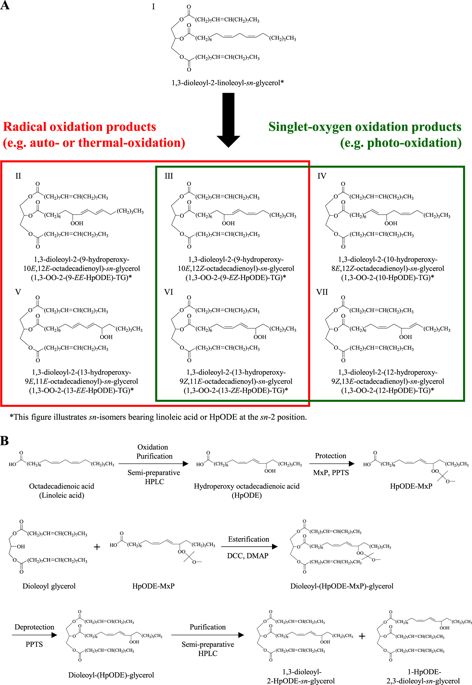npj Science of Food ( IF 6.3 ) Pub Date : 2018-01-12 , DOI: 10.1038/s41538-017-0009-x Shunji Kato , Naoki Shimizu , Yasuhiko Hanzawa , Yurika Otoki , Junya Ito , Fumiko Kimura , Susumu Takekoshi , Masayoshi Sakaino , Takashi Sano , Takahiro Eitsuka , Teruo Miyazawa , Kiyotaka Nakagawa

|
Triacylglycerol (TG), the main component of edible oil, is oxidized by thermal- or photo- oxidation to form TG hydroperoxide (TGOOH) as the primary oxidation product. Since TGOOH and its subsequent oxidation products cause not only the deterioration of oil quality but also various toxicities, preventing the oxidation of edible oils is essential. Therefore understanding oxidation mechanisms that cause the formation of TGOOH is necessary. Since isomeric information of lipid hydroperoxide provides insights about oil oxidation mechanisms, we focused on dioleoyl-(hydroperoxy octadecadienoyl)-TG (OO-HpODE-TG) isomers, which are the primary oxidation products of the most abundant TG molecular species (dioleoyl-linoleoyl-TG) in canola oil. To secure highly selective and sensitive analysis, authentic OO-HpODE-TG isomer references (i.e., hydroperoxide positional/geometrical isomers) were synthesized and analyzed with HPLC-MS/MS. With the use of the method, photo- or thermal- oxidized edible oils were analyzed. While dioleoyl-(10-hydroperoxy-8E,12Z-octadecadienoyl)-TG (OO-(10-HpODE)-TG) and dioleoyl-(12-hydroperoxy-9Z,13E-octadecadienoyl)-TG (OO-(12-HpODE)-TG) were characteristically detected in photo-oxidized oils, dioleoyl-(9-hydroperoxy-10E,12E-octadecadienoyl)-TG and dioleoyl-(13-hydroperoxy-9E,11E-octadecadienoyl)-TG were found to increase depending on temperature in thermal-oxidized oils. These results prove that our methods not only evaluate oil oxidation in levels that are unquantifiable with peroxide value, but also allows for the determination of oil oxidation mechanisms. From the analysis of marketed canola oils, photo-oxidized products (i.e., OO-(10-HpODE)-TG and OO-(12-HpODE)-TG) were characteristically accumulated compared to the oil analyzed immediately after production. The method described in this paper is valuable in the understanding of oil and food oxidation mechanisms, and may be applied to the development of preventive methods against food deterioration.
中文翻译:

液相色谱-串联质谱法测定芥花籽油中三酰甘油的氧化机理
食用油的主要成分三酰基甘油(TG)通过热氧化或光氧化被氧化,形成TG氢过氧化物(TGOOH)作为主要的氧化产物。由于TGOOH及其随后的氧化产物不仅导致油质下降,而且还引起各种毒性,因此防止食用油的氧化至关重要。因此,有必要了解引起TGOOH形成的氧化机理。由于脂质氢过氧化物的异构信息提供了有关油氧化机理的见解,因此我们重点研究了油酰-(氢过氧十八碳烯基)-TG(OO-HpODE-TG)异构体,它们是最丰富的TG分子种类(二油酰-亚油酰基)的主要氧化产物。 -TG)在低芥酸菜子油中。为了确保高度选择性和灵敏的分析,请使用真实的OO-HpODE-TG异构体参考文献(即 合成氢过氧化物的位置/几何异构体,并用HPLC-MS / MS分析。使用该方法,对光氧化或热氧化的食用油进行了分析。而二油酰-(10-氢过氧-8E,12 Z-十八碳二烯酰基)-TG(OO-(10-HpODE)-TG)和二油酰基-(12-氢过氧-9 Z,13 E-十八碳二烯酰基)-TG(OO-(12-HpODE)-TG)是在光氧化油,二油酰-(9-氢过氧-10 E,12 E-十八碳二烯酰基)-TG和二油酰-(13-氢过氧-9 E,11 E发现十八烷基十八碳酰-TG随着热氧化油中温度的升高而增加。这些结果证明,我们的方法不仅可以评估过氧化值无法量化的油氧化程度,还可以确定油氧化机理。通过对市售低芥酸菜籽油的分析,与生产后立即分析的油相比,特征性地积累了光氧化产物(即OO-(10-HpODE)-TG和OO-(12-HpODE)-TG)。本文中描述的方法对于理解油和食物的氧化机理非常有价值,并可用于开发防止食物变质的预防方法。











































 京公网安备 11010802027423号
京公网安备 11010802027423号